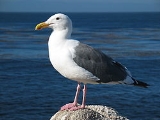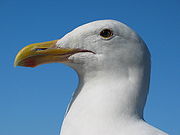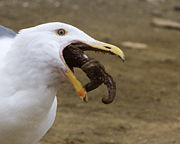
Western Gull
Encyclopedia
The Western Gull, Larus occidentalis, is a large white-headed gull
that lives on the western coast of North America
. It was previously considered conspecific, the same species, with the Yellow-footed Gull
(Larus livens) of the Gulf of California
. The Western Gull ranges from British Columbia
, Canada to Baja California
, Mexico, and because of its convenient colonies on the coast of California
it is well studied. Despite being a well-known bird
species on the West Coast of the US
, it is of some slight conservation
concern given its restricted range (for a gull).
(Larus schistisagus). In the north of its range it forms a hybrid zone
with its close relative the Glaucous-winged Gull
(Larus glaucescens). Western gulls take approximately four years to reach their full plumage
, their layer of feathers and the patterns and colors on the feathers. The Western Gull typically lives about 15 years, but can live to at least 25 years. The largest Western gull colony is on the Farallon Islands
, located about 26 mi (41.8 km) west of San Francisco, California.
gull. It nests on offshore islands and rocks along the coast, and on islands inside estuaries
, and a colony also exists on Alcatraz Island
in San Francisco Bay
. In the colonies, long term pairs aggressively defend territories whose borders may shift slightly from year to year, but are maintained for the life of the male.
and invertebrate
s like krill
, squid
and jellyfish
. They cannot dive, and feed exclusively on the surface. On land they feed on seal and sea lion
carcasses, as well as cockle
s, limpet
s and snail
s in the intertidal zone. They also feed on human food refuse, in human-altered habitats, including waste landfill
s, and taking food from people at marinas and beaches. At times some Western Gulls can be predatory, preying on the young of other birds and even adults of some species. One Western Gull at Oakland's Lake Merrit was known for killing and eating pigeons (Rock Doves) on a daily basis. Western Gulls also will snatch a fish from a cormorant's or pelican's mouth before it is swallowed.
d. Chicks straying into the territory of another gull are liable to be killed by that territory's pair. Chick mortality is high, with on average one chick surviving to fledging. On occasion, abandoned chicks will be adopted by other gulls.
, and may closely resemble a Thayer's Gull
. The hybrids have a flatter and larger head and a thicker bill with a pronounced angle on the lower part of the bill, which distinguishes it from the smaller Thayer's Gull.
eggs for the growing city of San Francisco. Western Gull colonies also suffered from disturbance where they were turned into lighthouse
stations, or, in the case of Alcatraz, a prison.
Western Gulls are very aggressive when defending their territories and consequently were persecuted by some as a menace. The automating of the lighthouses, and the closing of Alcatraz Prison, allowed the species to reclaim parts of its range. They are currently vulnerable to climatic events like El Niño events and oil spill
s.
's famous movie
, The Birds
, which was filmed in Bodega Bay, California
.
Gull
Gulls are birds in the family Laridae. They are most closely related to the terns and only distantly related to auks, skimmers, and more distantly to the waders...
that lives on the western coast of North America
North America
North America is a continent wholly within the Northern Hemisphere and almost wholly within the Western Hemisphere. It is also considered a northern subcontinent of the Americas...
. It was previously considered conspecific, the same species, with the Yellow-footed Gull
Yellow-footed Gull
The Yellow-footed Gull, Larus livens, is a large gull, closely related to the Western Gull and thought to be a subspecies until the 1960s....
(Larus livens) of the Gulf of California
Gulf of California
The Gulf of California is a body of water that separates the Baja California Peninsula from the Mexican mainland...
. The Western Gull ranges from British Columbia
British Columbia
British Columbia is the westernmost of Canada's provinces and is known for its natural beauty, as reflected in its Latin motto, Splendor sine occasu . Its name was chosen by Queen Victoria in 1858...
, Canada to Baja California
Baja California
Baja California officially Estado Libre y Soberano de Baja California is one of the 31 states which, with the Federal District, comprise the 32 Federal Entities of Mexico. It is both the northernmost and westernmost state of Mexico. Before becoming a state in 1953, the area was known as the North...
, Mexico, and because of its convenient colonies on the coast of California
California
California is a state located on the West Coast of the United States. It is by far the most populous U.S. state, and the third-largest by land area...
it is well studied. Despite being a well-known bird
Bird
Birds are feathered, winged, bipedal, endothermic , egg-laying, vertebrate animals. Around 10,000 living species and 188 families makes them the most speciose class of tetrapod vertebrates. They inhabit ecosystems across the globe, from the Arctic to the Antarctic. Extant birds range in size from...
species on the West Coast of the US
United States
The United States of America is a federal constitutional republic comprising fifty states and a federal district...
, it is of some slight conservation
Conservation biology
Conservation biology is the scientific study of the nature and status of Earth's biodiversity with the aim of protecting species, their habitats, and ecosystems from excessive rates of extinction...
concern given its restricted range (for a gull).
Description
The Western Gull is a large gull, around 60 cm long with a white head and body, and gray wings. It has a yellow bill with a red subterminal spot (this is the small spot near the end of the bill that chicks peck in order to stimulate feeding). It closely resembles the Slaty-backed GullSlaty-backed Gull
The Slaty-backed Gull , is a large white-headed gull that breeds on the western coast of Alaska but travels widely during nonbreeding seasons. Claims have been made as to its presence throughout North America as well as the eastern coast of Asia. It is similar in appearance to the Western Gull...
(Larus schistisagus). In the north of its range it forms a hybrid zone
Hybrid zone
A hybrid zone exists where the ranges of two interbreeding species meet. For a hybrid zone to be stable, the offspring produced by the cross have to be less fit than members of the parent species, although this condition does not need to be met in the very first hybrid generation...
with its close relative the Glaucous-winged Gull
Glaucous-winged Gull
The Glaucous-winged Gull, Larus glaucescens, is a large, white-headed gull residing from the western coast of Alaska to the coast of Washington. It also breeds on the northwest coast of Alaska. During non-breeding seasons they can be found along the coast of California...
(Larus glaucescens). Western gulls take approximately four years to reach their full plumage
Plumage
Plumage refers both to the layer of feathers that cover a bird and the pattern, colour, and arrangement of those feathers. The pattern and colours of plumage vary between species and subspecies and can also vary between different age classes, sexes, and season. Within species there can also be a...
, their layer of feathers and the patterns and colors on the feathers. The Western Gull typically lives about 15 years, but can live to at least 25 years. The largest Western gull colony is on the Farallon Islands
Farallon Islands
The Farallon Islands, or Farallones , are a group of islands and sea stacks in the Gulf of the Farallones, off the coast of San Francisco, California, USA. They lie outside the Golden Gate and south of Point Reyes, and are visible from the mainland on clear days...
, located about 26 mi (41.8 km) west of San Francisco, California.
Behavior
The Western Gull is rarely encountered inland or away from the ocean and is almost an exclusively marineOcean
An ocean is a major body of saline water, and a principal component of the hydrosphere. Approximately 71% of the Earth's surface is covered by ocean, a continuous body of water that is customarily divided into several principal oceans and smaller seas.More than half of this area is over 3,000...
gull. It nests on offshore islands and rocks along the coast, and on islands inside estuaries
Estuary
An estuary is a partly enclosed coastal body of water with one or more rivers or streams flowing into it, and with a free connection to the open sea....
, and a colony also exists on Alcatraz Island
Alcatraz Island
Alcatraz Island is an island located in the San Francisco Bay, offshore from San Francisco, California, United States. Often referred to as "The Rock" or simply "Traz", the small island was developed with facilities for a lighthouse, a military fortification, a military prison, and a Federal...
in San Francisco Bay
San Francisco Bay
San Francisco Bay is a shallow, productive estuary through which water draining from approximately forty percent of California, flowing in the Sacramento and San Joaquin rivers from the Sierra Nevada mountains, enters the Pacific Ocean...
. In the colonies, long term pairs aggressively defend territories whose borders may shift slightly from year to year, but are maintained for the life of the male.
Feeding
Western Gulls feed in pelagic environments, areas in the ocean not near the shore, and in intertidal environments, areas exposed to the air at low tide and underwater at high tide. At sea they take fishFish
Fish are a paraphyletic group of organisms that consist of all gill-bearing aquatic vertebrate animals that lack limbs with digits. Included in this definition are the living hagfish, lampreys, and cartilaginous and bony fish, as well as various extinct related groups...
and invertebrate
Invertebrate
An invertebrate is an animal without a backbone. The group includes 97% of all animal species – all animals except those in the chordate subphylum Vertebrata .Invertebrates form a paraphyletic group...
s like krill
Krill
Krill is the common name given to the order Euphausiacea of shrimp-like marine crustaceans. Also known as euphausiids, these small invertebrates are found in all oceans of the world...
, squid
Squid
Squid are cephalopods of the order Teuthida, which comprises around 300 species. Like all other cephalopods, squid have a distinct head, bilateral symmetry, a mantle, and arms. Squid, like cuttlefish, have eight arms arranged in pairs and two, usually longer, tentacles...
and jellyfish
Jellyfish
Jellyfish are free-swimming members of the phylum Cnidaria. Medusa is another word for jellyfish, and refers to any free-swimming jellyfish stages in the phylum Cnidaria...
. They cannot dive, and feed exclusively on the surface. On land they feed on seal and sea lion
Sea Lion
Sea lions are pinnipeds characterized by external ear-flaps, long fore-flippers, the ability to walk on all fours, and short thick hair. Together with the fur seal, they comprise the family Otariidae, or eared seals. There are six extant and one extinct species in five genera...
carcasses, as well as cockle
Cockle (bivalve)
Cockle is the common name for a group of small, edible, saltwater clams, marine bivalve molluscs in the family Cardiidae.Various species of cockles live in sandy sheltered beaches throughout the world....
s, limpet
Limpet
Limpet is a common name for a number of different kinds of saltwater and freshwater snails ; it is applied to those snails that have a simple shell which is more or less conical in shape, and either is not spirally coiled, or appears not to be coiled in the adult snails.The name limpet is most...
s and snail
Snail
Snail is a common name applied to most of the members of the molluscan class Gastropoda that have coiled shells in the adult stage. When the word is used in its most general sense, it includes sea snails, land snails and freshwater snails. The word snail without any qualifier is however more often...
s in the intertidal zone. They also feed on human food refuse, in human-altered habitats, including waste landfill
Landfill
A landfill site , is a site for the disposal of waste materials by burial and is the oldest form of waste treatment...
s, and taking food from people at marinas and beaches. At times some Western Gulls can be predatory, preying on the young of other birds and even adults of some species. One Western Gull at Oakland's Lake Merrit was known for killing and eating pigeons (Rock Doves) on a daily basis. Western Gulls also will snatch a fish from a cormorant's or pelican's mouth before it is swallowed.
Reproduction
A nest of vegetation is constructed inside the territory, and three eggs are laid. These eggs are incubated for a month. The chicks, once hatched, remain inside the territory until they have fledgeFledge
Fledge is the stage in a young bird's life when the feathers and wing muscles are sufficiently developed for flight. It also describes the act of a chick's parents raising it to a fully grown state...
d. Chicks straying into the territory of another gull are liable to be killed by that territory's pair. Chick mortality is high, with on average one chick surviving to fledging. On occasion, abandoned chicks will be adopted by other gulls.
Hybridization
In Washington state, the Western Gull hybridizes frequently with the Glaucous-winged GullGlaucous-winged Gull
The Glaucous-winged Gull, Larus glaucescens, is a large, white-headed gull residing from the western coast of Alaska to the coast of Washington. It also breeds on the northwest coast of Alaska. During non-breeding seasons they can be found along the coast of California...
, and may closely resemble a Thayer's Gull
Thayer's Gull
The Thayer's Gull is a large gull native to North America that breeds in the Arctic islands of Canada and primarily winters on the Pacific coast, from southern Alaska to the Gulf of California, though there are also wintering populations on the Great Lakes and the upper Mississippi River...
. The hybrids have a flatter and larger head and a thicker bill with a pronounced angle on the lower part of the bill, which distinguishes it from the smaller Thayer's Gull.
Western Gulls and humans
The Western Gull is currently not considered threatened. However, they have, for a gull, a restricted range. Numbers were greatly reduced in the 19th century by the taking of seabirdSeabird
Seabirds are birds that have adapted to life within the marine environment. While seabirds vary greatly in lifestyle, behaviour and physiology, they often exhibit striking convergent evolution, as the same environmental problems and feeding niches have resulted in similar adaptations...
eggs for the growing city of San Francisco. Western Gull colonies also suffered from disturbance where they were turned into lighthouse
Lighthouse
A lighthouse is a tower, building, or other type of structure designed to emit light from a system of lamps and lenses or, in older times, from a fire, and used as an aid to navigation for maritime pilots at sea or on inland waterways....
stations, or, in the case of Alcatraz, a prison.
Western Gulls are very aggressive when defending their territories and consequently were persecuted by some as a menace. The automating of the lighthouses, and the closing of Alcatraz Prison, allowed the species to reclaim parts of its range. They are currently vulnerable to climatic events like El Niño events and oil spill
Oil spill
An oil spill is the release of a liquid petroleum hydrocarbon into the environment, especially marine areas, due to human activity, and is a form of pollution. The term is mostly used to describe marine oil spills, where oil is released into the ocean or coastal waters...
s.
Gallery
 |
 |
In media
The Western Gull was one of the antagonists in Alfred HitchcockAlfred Hitchcock
Sir Alfred Joseph Hitchcock, KBE was a British film director and producer. He pioneered many techniques in the suspense and psychological thriller genres. After a successful career in British cinema in both silent films and early talkies, Hitchcock moved to Hollywood...
's famous movie
Film
A film, also called a movie or motion picture, is a series of still or moving images. It is produced by recording photographic images with cameras, or by creating images using animation techniques or visual effects...
, The Birds
The Birds (film)
The Birds is a 1963 horror film directed by Alfred Hitchcock based on the 1952 short story "The Birds" by Daphne du Maurier. It depicts Bodega Bay, California which is, suddenly and for unexplained reasons, the subject of a series of widespread and violent bird attacks over the course of a few...
, which was filmed in Bodega Bay, California
Bodega Bay, California
Bodega Bay is a town and census-designated place in Sonoma County, California, United States. The population was 1,077 at the 2010 census. The town is on the eastern side of Bodega Harbor, an inlet of Bodega Bay on the Pacific coast....
.
External links
- Western Gull Facts - from University of Washington Nature Mapping Program
- Oregon Coast Today - Seagull article

